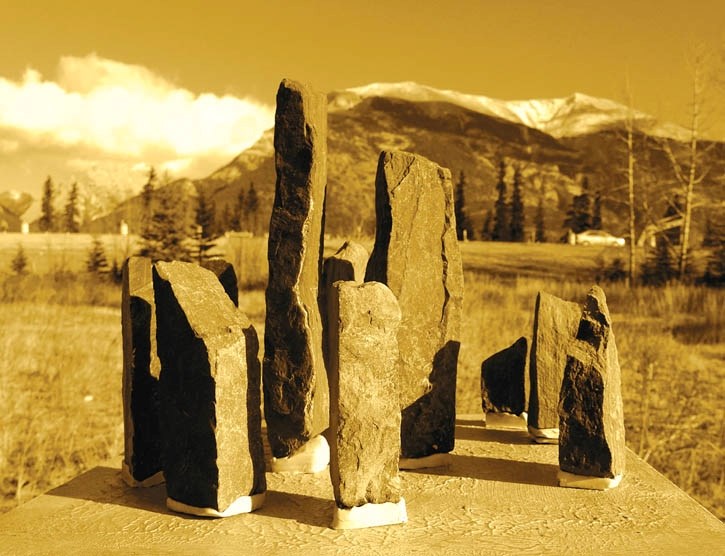Standing stones can be found throughout the world; in the Arctic, Japan and Europe, with Stonehenge, located on Salisbury Plain in England, being the most notable example.
Late this spring, Canmore will be home to its own standing stones when the municipality unveils its latest piece of community-owned public art designed by local artist Lucie Bause.
Bause was chosen as this year’s winning design as part of the public art competition hosted by the Canmore Public Art Committee, which this year was open only to Canmore residents.
Previous pieces of work chosen as part of the community public art process include the Big Head and Chinook.
Bause’s design, as yet unnamed, will be installed on the south side of the Trans-Canada Highway near the entrance to the pedestrian underpass and will feature 12 standing stones quarried locally at Thunderstone Quarries, located near Dead Man’s Flats
The stones range in size from 2.4 metres tall to about a half metre, arranged in a large spiral that measures about 12 metres in diameter.
The tallest piece of stone, , will sit in the middle at the heart of the spiral. From there the Rundle rock stones descend in size with the smallest stones at the outside of the spiral.
Bause said the smallest outside stones would be “small enough to sit on and hang out and we know people love to interact with public art, so why not incorporate that into the design and intentionally have people interact with it?”
The environmental sculpture will be unveiled June 17 during the 2011 Canmore artsPeak Arts Festival.
Bause said recently she drew inspiration for the sculpture from Stonehenge, the Arctic and Japanese Zen gardens as she worked to create a relationship between the sculpture and the site.
“It was based on those ideas, but unique and simple. I chose the spiral shape because it occurs in nature on various levels of magnitude, the micro level and the macro level,” she said. “It is a dynamic shape that has various meanings in different cultures throughout the world but it is a universal symbol. It is quite the dynamic shape and it also invites people to walk in amongst the sculpture.”
Like the Inukshuk the Inuit would build to guide their way, Bause said she envisions her sculpture as a landmark and a guide between the Benchlands and the subdivisions along Highway 1A.
She also sees it, perhaps, referencing a sundial, a compass and as a way to mark the summer and winter solstices – all ideas suggested to her by residents of Canmore familiar with her project.
“It is a very exciting project for me. I’m really excited about this process because it will be such a learning experience. It already has been so far. As it evolves, there’s more and more layers of information and things I have to consider in all the various manners,” she said.
But she also faces some challenges presented by the site, specifically a nearby water main, anchoring the stones and ensuring public safety.
Even though it is her idea and commission, Bause said it is more of a community project as she is planning to use local materials, including the cement, and partnerships with Thunderstone Quarries and Paulco Landscaping.
“The community is chipping in to get this thing built, so to me that tells me it’s being well-received,” she said.




